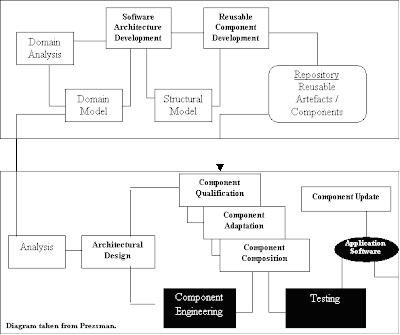Component based software engineering (CBSE) offers inherent benefits in software quality, developer productivity, and overall system cost. And yet, many roadblocks remain to be overcome before the CBSE process model is widely used throughout the industry. The benefits of object-oriented design and component-based development seem obvious:
- Reusing software saves money in the development phase of software projects, i.e., the more components you reuse, the less software you have to build.
- The more applications in which you use a given component, the more valuable that component becomes.
- Reusable components enable application developers to customize applications without high costs and long development cycles.
- Reused software components have fewer bugs because they are used more often, and errors are uncovered and corrected along the way.
Why CBSE?
The goal of component-based software engineering is to increase the productivity, quality, and time-to-market in software development thanks to the deployment of both standard components and production automation. One important paradigm shift implied here is to build software systems from standard components rather than "reinventing the wheel" each time. This requires thinking in terms of system families rather than single systems. CBSE uses Software Engineering principles to apply the same idea as OOPs to the whole process of designing and constructing software systems. It focuses on reusing and adapting existing components, as opposed to just coding in a particular style. CBSE encourages the composition of software systems, as opposed to programming them.
CBSE should, in theory, allow software systems to be more easily assembled, and less costly to build. Although this cannot be guaranteed, the limited experience of adopting this strategy has shown it to be true. The software systems built using CBSE are not only simpler to bold and cheaper – but usually turn out to be more robust, adaptable and updateable.
CBSE allows use of predictable architectural patterns and standard software architecture leading to a higher quality end result.
The CBSE Process :
CBSE is in many ways similar to conventional or object-oriented software engineering. A software team establishes requirements for the system to be built using conventional requirements elicitation techniques. An architectural design is established. Here though, the process differs. Rather than a more detailed design task, the team now examines the requirements to determine what subset is directly amenable to composition, rather than construction. For each requirement, the team will ask:
- Are commercial off-the-shelf (COTS) components available to implement the requirement?
- Are internally developed reusable components available to implement the requirement?
- Are the interfaces for available components compatible within the architecture of the system to be built?
The team will attempt to modify or remove those system requirements that cannot be implemented with COTS or in-house components. The CBSE process identifies not only candidate components but also qualifies each components’ interface, adapts components to remove architectural mismatches, assembles components into selected architectural style, and updates components as requirements for the system change.
There are two processes that occur in parallel during the CBSE process. These are:
* Domain Engineering
* Component Based Development
Wednesday, September 16, 2009
Component Based Software Engineering (CBSE)
Posted by
Sunflower
at
9/16/2009 02:17:00 PM
![]()
Labels: CBSE, CBSE process, Component based Software Engineering, Need, software engineering
|
| Subscribe by Email |
|
Subscribe to:
Post Comments (Atom)
No comments:
Post a Comment